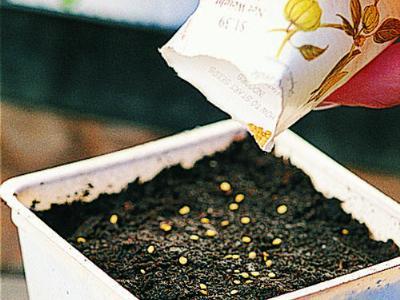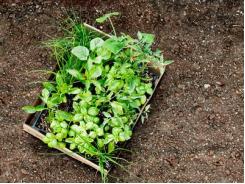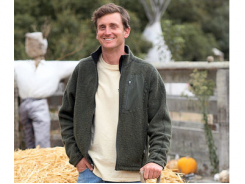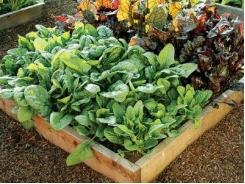How to start seeds indoors

Vegetables like tomatoes, peppers, and eggplant, need a long, warm growing season to produce a harvest.
If you plan to grow your own seedlings, start such crops indoors in late winter in order to have plants ready to set out in the garden when the weather has warmed up.
If you want to plant tomato seedlings in May, for instance, you'll need to start those seeds by early March.
Starting seeds in containers is also a useful way to have plants of winter crops, such as broccoli and cabbage, ready to transplant into the garden in early spring or fall.
You can use a variety of containers, including flats or trays (with or without dividers), small individual pots, and cell-packs. If you’re reusing old containers, scrub them out, and soak them for half an hour in a solution of one part household bleach to nine parts hot water to destroy any disease organisms.
Seeds to seedlings
1. Fill 4-inch pots to just below the rim with a light, porous seed-starting or potting mix. (You can make your own mix by combining 1 part each of peat moss, vermiculite, and perlite.) Moisten the mix, and let it drain.
Scatter seeds thinly over the surface. Check the seed packet for the recommended planting depth, and cover the seeds with the proper amount of mix. (As a rule of thumb, cover seeds to a depth equal to twice their diameter.) Label each container with the plant’s name and the date. Moisten the soil lightly.
Next: transplanting
If you are starting heat-loving plants (tomatoes, cucumbers, eggplant, okra, peppers, squashes, or melons), set the containers on a water heater or use a heating mat to keep the soil between 75°F/24°C and 90°F/32°C. (Most cool-season vegetables will germinate at room temperature.)
When the seeds germinate, move the pots into an area with bright light and temperatures between 60°F/16°C and 75°F/24°C.
2. When the seedlings develop their second set of true leaves, it’s time to transplant them to individual pots, such as 3- or 4-inch plastic pots. Fill the new containers with potting mix, moisten the mix, and let it drain.
To remove the seedlings from their original pots, squeeze each pot’s sides, and turn it upside down, keeping one hand around the soil ball. With both hands, carefully pull the soil ball apart, and set it down on a flat surface.
3. Separate the fragile rootballs of the seedlings from one another with a toothpick or skewer, or tease them apart with your fingers.
4. Poke a hole in the new container’s potting mix. Carefully lift each seedling and its rootball, keeping your fingers under it for support. Place the seedling in its new container, and firm the mix around it. Water immediately, and then set the pots in bright light (but keep them out of direct sunlight for a few days). Feed the seedlings weekly with a fertilizer sold for starting seeds or with a liquid type diluted to half-strength.
Next: give them light and warmth
Give them warmth and light
Seedlings of edible crops need bright light to develop properly; when grown in conditions that are too dark, the seedlings are spindly and weak. If you don’t have a suitable place for your seedlings, try growing them under fluorescent lights. As soon as the seeds sprout, give them 12 to 14 hours of light each day, setting the light fixture 6 to 8 inches above the tops of the plants.
Seeds of heat-loving summer crops need warm soil to germinate quickly and strongly. Thin waterproof heating mats placed under the containers keep the soil 15 to 20°F/8 to 11°C above room temperature.
Nurseries and mail-order catalogs offer both fluorescent light kits and heating mats.
Avoid "damping off" trouble
If your seedlings suddenly collapse and die, one of the fungal diseases called "damping off" or "seed and seedling rot" may be to blame. In one type of damping off, the seedling's stem collapses at or near the soil surface; in another type, the seedling rots before it emerges from the soil, or the seed decays before it even sprouts.
To prevent these problems, use pasteurized potting mix and new or thoroughly washed and disinfected containers.
Take care not to overwater seedlings; be sure to provide good air circulation and ventilation, so tops of seedlings stay dry and standing moisture is kept to a minimum. Thinning seedlings to eliminate crowding is also helpful.
Tools

Phối trộn thức ăn chăn nuôi

Pha dung dịch thủy canh

Định mức cho tôm ăn

Phối trộn phân bón NPK

Xác định tỷ lệ tôm sống

Chuyển đổi đơn vị phân bón

Xác định công suất sục khí

Chuyển đổi đơn vị tôm

Tính diện tích nhà kính

Tính thể tích ao




 Our essential guide to pruning fruit trees
Our essential guide to pruning fruit trees  Grow your own greens
Grow your own greens